Lejonklou Källa Streamer/DAC by David Abramson

 Standard Bearer
Standard Bearer
As much as I have coveted and experienced other gear, in recent years, I’ve most often come back to Lejonklou, specifically to their modestly if adequately powered Boazu integrated. Containing the essence of the Lejonklou sound if not its full expression (there is certainly pricier and more powerful Lejonklou gear on offer), the Boazu is a leave-it-on-all-the-time convenient, electrically quiet, reliable, and musically expressive benchmark in a Plain Jane black box which not much in my experience (at least at my low to moderate listening levels) has surpassed.
For some time, I’ve wanted to get my ears around the Lejonklou all-in-one DAC/Streamer (or Streamer/DAC, the Källa). So when Tom, the USA head of the Lejonklou army, called, I made it my business to answer.
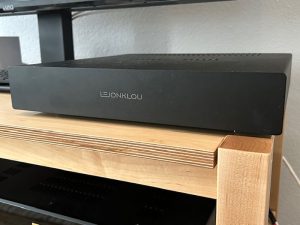
Send me one.
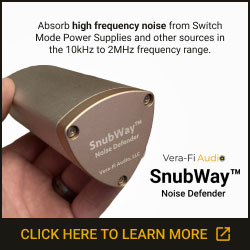 The Källa (and it’s pronounced Sheh-la apparently) is an all-in-one umlauted streamer/DAC in the aforementioned plainest of the plain black textured boxes, the same one as a Boazu. During the review, I reached for one when I meant to reach for the other on more than one occasion. Before we reach for the correct box and get going, I want to point out that while the rest of the world may love a bundle, audiophiles are known to HATE them. Active speakers anyone? Yeah- they’ll catch on any day now, like soccer!
The Källa (and it’s pronounced Sheh-la apparently) is an all-in-one umlauted streamer/DAC in the aforementioned plainest of the plain black textured boxes, the same one as a Boazu. During the review, I reached for one when I meant to reach for the other on more than one occasion. Before we reach for the correct box and get going, I want to point out that while the rest of the world may love a bundle, audiophiles are known to HATE them. Active speakers anyone? Yeah- they’ll catch on any day now, like soccer!
Convenience to us audio people somehow equals compromise and, of course, the inability to swap gear once you realize you’ve been compromised. That’s a deal breaker. Or is it? Maybe the electrical characteristics of your streamer are optimized for the same company’s DAC. Maybe the elimination of another set of interconnects isn’t a bad thing? (Unless you’re one of those ‘bits are bits’ guys, just get yourself one of those 150-dollar streamers/DACs, wire it up with Amazon’s best, and you’re good! Lucky you). Maybe some tech companies got it right, and single-chef synergy, the hardware with the soft, lifts all boats.
In any case, this non-woke ‘anti-bundle’ mentality does seem to be changing with the advent of the YouTube reviewer and their ceaseless touting of the newest techie all-in-one, replete, of course, with larger and larger touchscreens. (The need for which, well… they ARE pretty, I guess.)
Yeah, we ‘philes may be slow in warming to a bundle, but designers of gadgets are not. They very much love top-to-bottom control over the finished product: Apple, Ferrari, Dyson, et al. Sure, it’s Machiavellian, but what better way is there to ensure the thing functions and sounds tip to tail precisely as intended? Yep. Steve Jobs. Eelco Grimm. Fredrik Lejonkou. Black turtlenecks and strict vegan diets all around!
Well, from what I can tell, Fredrik isn’t (yet) into bespoke black turtlenecks, but there’s definitely something to be said for a master designer making your front-end idiot-proof.

Källa to Arms
And the Källa is more or less idiot-proof. You connect your ethernet cable and RCA outputs to your amp (sorry, no balanced outs), and Tom’s your uncle. That simple. Then, you choose your control point—iPhone, iPad, etc. Per Tom at Nokturne, the transfer protocol Lejonklou designed needs an Apple device but it controls the transfer. Tom continued, “the transfer by our Protokoll is transparent so it will stream whatever your device tells it to and you control it with the software you want to stream from, Spotify, Qobuz, Radio Paradise, YouTube, etc.” As a fun fact, Fredrik’s wife apparently came up with Protokoll. I like it!
Another fun fact is there’s a three-person design team. Fredrik and the two programmers on that team have been working on this device for four years, and the low level programmer wishes to remain completely anonymous. Ah, the Ghost in the Machine!
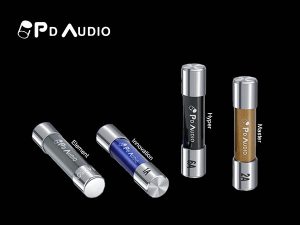 During the development of the Källa, so the story goes, Fredrik was on a train traveling to visit his mother when the (mysterious) Main Programmer called him with a simple message. “Don’t. Change. A thing. This thing is now perfect as is – sounds like I’ve got a perfectly tuned subwoofer for bass, except there’s no subwoofer!” And that was apparently that: the end of the testing and refinement of the finished product.
During the development of the Källa, so the story goes, Fredrik was on a train traveling to visit his mother when the (mysterious) Main Programmer called him with a simple message. “Don’t. Change. A thing. This thing is now perfect as is – sounds like I’ve got a perfectly tuned subwoofer for bass, except there’s no subwoofer!” And that was apparently that: the end of the testing and refinement of the finished product.
The finished product ended up being 16/44kHz only. Period. Full stop. There is no oversampling, no sampling, and no simple random sampling. Why? “This is a Lejonklou product, so it’s not about specifications,” Tom says. “Fredrik says if this is how it should sound and that’s what’s important, so that’s why it’s 16bit 44kHz. He shuns upsampling. In fact, it down samples 24/96kHz to 16/44kHz.“ Lejonklou WILL get hate mail—a lot of it. Yeah, the Källa is for the customer (and you know who you are) who listens to music, not specs, wants ease of use to boot without a finicky minimalist app, etc.
Regarding the Källa’s internals, while it utilizes a selected Asus board, per Tom, a number of things in it were tweaked and tuned. There is also apparently another board below that board of Fredrik’s own design, and it uses a customized DAC circuit and analog output stage. “95% of the DAC in Källa is regulators and control systems. They feed and control an AKM AK4358VQ DAC chip, which is an 8-channel DAC on which the two best sounding channels are used and the other six are inactive.” In fact, rumor has it the circuit boards may be the same or very similar to the ones in the 55,000 dollar SINGularity phono stage and are apparently from the same German company. Other companies like Meitner apparently think alike in terms of the effect of board quality and composition on their end product. Indeed, their highest-end DAC, the DV2, utilizes higher-quality boards of different compositions compared with the boards in the excellent but lower-priced MA3 DAC I used to own.
Continuing with the Källa’s internals, Tom tells me there is a copper heat sink for a power supply regulator, and it is, in fact, a switch-mode power supply. Fredrik apparently tried dual switch-mode supplies, and they sounded (drum roll) worse. They had to drive the computer board and the other board from the same power supply to sound their best, so that’s what they went with. The irony is that besides wine dinners with friends (I don’t know if he drinks), Tom probably doesn’t stream much himself because he’s likely among the world’s foremost LP12 turntable setup men. To hear Tom tell it, though, the result of all this (textured) black box alchemy is that Källa is about the closest approach he’s heard digitally to a well-set-up, properly torqued, and tuned LP12.
Me? I’ve heard and owned lots of DACs and streamers from a Mac mini to a Bluesound to a Lumin to an Innuos to a Nucleus to DCS Mosaic on a Bartok Apex to (much) more recently, a Grimm MU2. Still, I’ve never heard a perfectly tuned and torqued LP12 or, for that matter, any LP12 of any ilk. My life is the poorer. (It gets worse. I’ve also never heard of a well-set pair of Ls3/5A’s. There. Now, it’s all out in the open. Let’s move on, shall we?) More about Källa, but first, it’s time for…
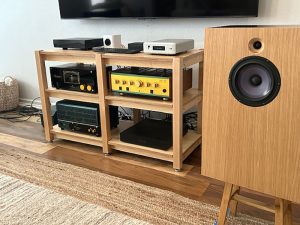
Serious System Tawk
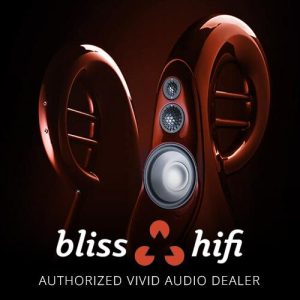 Had to sell my Devore O/96’s. After trading ‘up‘ from the Super Nines, I seemingly simply couldn’t give them enough space to ‘couple‘ well with my room. They were (perhaps of necessity) too close to the front wall for proper imaging/staging, and despite this- I never could get adequate bass in here, let alone overwhelming bass (even with them almost right up against my front wall!) My room has problems, and likely the limited range of available seating positions and squarish shape are chief among them. Bringing the 96s out three feet into the room served both to increase staging and depth while doing nothing to improve bass performance. It also served to seriously piss off my significant other. I simply couldn’t make them work here in all ways.
Had to sell my Devore O/96’s. After trading ‘up‘ from the Super Nines, I seemingly simply couldn’t give them enough space to ‘couple‘ well with my room. They were (perhaps of necessity) too close to the front wall for proper imaging/staging, and despite this- I never could get adequate bass in here, let alone overwhelming bass (even with them almost right up against my front wall!) My room has problems, and likely the limited range of available seating positions and squarish shape are chief among them. Bringing the 96s out three feet into the room served both to increase staging and depth while doing nothing to improve bass performance. It also served to seriously piss off my significant other. I simply couldn’t make them work here in all ways.
Queue a serendipitous loan offer from a friend of a pair of Devore O/baby’s (possible review pending!). I had a hunch that these smaller Os might work better here, and indeed, these little apes somehow latched on and/or coupled to my room shortly after the break-in and wouldn’t let go! Presto! Bass galore! Ok, at least comparatively. It’s much better here than the much larger O/96 or the Super Nine! And from a 7“ driver in a smaller box! Go figure! (I’ve since also had the micr/O’s in here, a sealed design, and similarly great stuff from this, the smallest Devore!)
I kind of feel in good company, as Ken Micallef of Stereophile experienced the same issue in his room but for different reasons; it’s really friggin’ small!! The whole exercise showed me that the most important component in a system is far away from the room and, more properly, the room/speaker interface.
You could have half-million dollar Magicos like Tom Cruise (he apparently does!), but in the wrong room for them, you’d rather have a pair of smaller Harbeths or micr/Os. Trust me when I say that I am 100 percent sure Tom Cruise does have the right room. He’s simply a more successful film star than I’ll ever be.
But in my current room, I’d take the Devore O/babys or the micr/O’s over any large speaker I’ve tried (especially when I added Rel Carbon subs! But that’s for another day!) It could be the small single port or what have you, but synergy between speakers and a room is not a myth—and it means you may not have to spend as much money as you think you do on the very biggest baddest speakers you can find.
Speaker choice sorted, we turn our attention to amps and wires. For this review, like some renaissance artists before me, I was privileged to have multiple wealthy benefactors: the aforementioned guy loaning me his O/baby’s and my other stereo buddy who wanted me to hear his Audio Note Oto Phono SE Signature and Leben 300xs. I also had on hand my trusty Lejonklou Boazu integrated amplifier along with the legendary(?) Lavorgna favorite Leben 600x AND the Aurorasound HFSA-01 el84 integrated. So I was NOT hurtin’ for amps to pair with the Källa!
I also got to play around with Audio Note Isis interconnects, LX bi-wire speaker cables, Audioquest Thunderbird interconnects, Robin Hood speaker cables, Skywire 1400SE interconnects, and Jeff Day-approved Belden 8402 interconnects. I wasn’t hurting for wires, either! I know; I better get to painting a decent still life with Källa and fruit, or they won’t lend me their gear again.
Forum Wisdom
 On the Lejonklou forum (yes, they have one!), there’s a whole section devoted to the Källa streamer/DAC. What’s more, there’s a lot of reading to do about control points for it, i.e., what device you use to send your bits to it, because apparently, they all sound different!
On the Lejonklou forum (yes, they have one!), there’s a whole section devoted to the Källa streamer/DAC. What’s more, there’s a lot of reading to do about control points for it, i.e., what device you use to send your bits to it, because apparently, they all sound different!
This year’s hottest control point is an iPad mini 6 in an apparent tie with the iPhone 14 and the iPhone 15 or 15 pro max in a close second place. No mini 6 here, but I do have an iPhone 14, so that should get pretty close. They also happen to strongly recommend against Roon, as they feel it’s ‘dead and boring‘ on the Källa compared with what it’s optimized for—Spotify! Yeah, I know!
I’m sorry, Roon lovers, but Fredrik feels Spotify is simply more ‘musical and engaging‘ than Roon, and the Källa has been optimized for it. (Contrast this with Eelco Grimm, who has optimized his streamers for the Roon protocol.) Ultimately, I also really liked Qobuz on it, but more on that in a bit (no pun intended. OK, it was!).
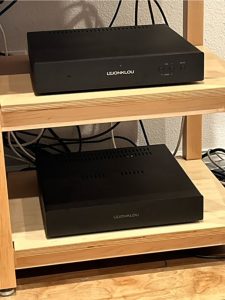
There’s Something about Källa
People say there’s a huge difference between live music and recorded and strictly speaking, that may be so, but the human mind is primed for fantasy and abstraction (and delusion), and many times, eyes closed, the Källa/Oto SE Sig/O/baby system, especially with smaller scale fare, had me believing I was there or they were here. Such was the tonal truth, purity, sweep, and dynamism of the system with certain material that, yeah, at times, I was able to suspend disbelief and give myself over to the premise that this really could be taking place here and now.
Image width and dynamics were simply incredible on the Chick Corea Trio’s ‘Trilogy‘ album streamed via Spotify, and I was rapt. I don’t think I’ve had quite this level of sonics from prior systems in prior setups in here; truly (almost) believable. The natural fluidity and relative tonal evenhandedness of the Källa contributed to creating many moments like this.
In truth, optimizing my ancillaries for each system change helped as well. When I subbed in the aforementioned Audio Note Lexus bi-wire speaker cables, a friend loaned me my usual Linn K20s. There was a wow moment for sure here, as we had system synergy in spades, and the Oto SE Sig amp opened up in a way I hadn’t heard it do previously.
The Audio Note Isis interconnects, and Lexus speaker cables synergized with the Källa/Oto combo to create among the most musical systems I have ever heard in my less-than-ideal current room. I almost felt like I suddenly had a dedicated, treated listening room, and I most certainly do not. Okay, there are a few panels up, but that’s about the extent of it. Terrific, really! This was promising. Before further listening and more specific thoughts on the Källa, though, since it’s a networked device, permit me to engage in a brief…
Networking digression
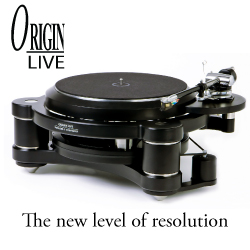 For some time, I’ve been using Lejonklou’s recommended Wi-Fi setup. This consists of one Amplifi HD router as your main router (connected to your wall via coax) and one more of them near your stereo rack connected wirelessly to the main router; in other words, paired with it as a mesh point. You then run your Blue Jeans ethernet cable (Fredrik’s preferred brand) from that second wirelessly connected router to your Källa. Supposedly, there’s just something about the second router wirelessly connected to your main one that improves sound, perhaps because there’s no wired connection between them to carry noise, etc. If it pleases you, you can go to the Lejonklou forum and listen to recorded comparisons of routers direct to Källa and wifi-paired secondary routers into Källa. While there seems to be some debate as to whether this arrangement actually sounds ‘better‘ than a directly wired main router, I believe the party line is still that it somehow does.
For some time, I’ve been using Lejonklou’s recommended Wi-Fi setup. This consists of one Amplifi HD router as your main router (connected to your wall via coax) and one more of them near your stereo rack connected wirelessly to the main router; in other words, paired with it as a mesh point. You then run your Blue Jeans ethernet cable (Fredrik’s preferred brand) from that second wirelessly connected router to your Källa. Supposedly, there’s just something about the second router wirelessly connected to your main one that improves sound, perhaps because there’s no wired connection between them to carry noise, etc. If it pleases you, you can go to the Lejonklou forum and listen to recorded comparisons of routers direct to Källa and wifi-paired secondary routers into Källa. While there seems to be some debate as to whether this arrangement actually sounds ‘better‘ than a directly wired main router, I believe the party line is still that it somehow does.
In an attempt to guild this particular Wi-Fi Lilly, I played with some network switches, including the Lejonklou-approved Netgear GS108 T (latest version) and one or two other generic switches I had lying around. Now, I’ve played around with network switches before, and whether they improve matters sonically is often a question of what you’re looking to do and your particular network setup and front end. In this vein, it’s the exact same thing I’ve found with power conditioners over the years.
It may be some kind of tautology, but if your power delivery system benefits from a power conditioner, you’ll say, ‘Wow—power conditioning really makes a difference.’ And if you have (relatively) great power (and read Audio Science Review on the daily), in whatever way power can be great (little voltage variation, non-shared with a hundred people in your condo, making for low line noise, etc.), you’ll say it’s all snake oil and mirrors.
With the Källa, a network switch did seem to make a positive difference with some of the systems I assembled, namely a slight improvement in solidity, resolution, and pace. And in some cases, it added an unfortunate hint of edginess to the sound. As I say, YMMV. Also, Yolo and it’s cheap. So rather than listen to the objectivists in our hobby who absolutely KNOW this is nonsense, spend 30 bucks (returnable!) and see if you agree with their oscilloscope-based assertions. In my case, I do not. I definitely hear (mainly) tonal shifts among switches. While subtle and not always for the better, there they are.
By the way, plugging my Wi-Fi router and the network switch together as a pair into a second unfiltered Wiremold power strip and plugging said power strip into the second socket in the same wall plate yielded a slightly more relaxed/less edgy sound than plugging everything and its brother into the same unfiltered power strip and same socket. Again, this flies in the face (screens?) of oscilloscopes but is consistent with the Lejonklou recommendations for plugging arrangements.
Indeed, Boazu and Källa into one nine-outlet Wiremold L10320 power strip in one wall socket, and the Amplifi router plus or minus the recommended Netgear switch into another Wiremold and then into the other wall socket below it definitely provided the most at the once relaxed, dimensional, and engaging sound from the Källa-fronted system.
The Källa, the KTE May and the Pulse
 “A certain suavity. A fluidity maybe the Innuos/Holo doesn’t quite get. The latter combo may have a bit more ‘edge‘ to the proceedings. It’s a bit rougher; a bit ‘clangier‘ to the ear,“ I wrote in my notes. Been flipping a bit between Innuos Pulse using its excellent Sense app into the Holo KTE May DAC and the single box Källa streaming Spotify all into the Lebens (300XS and 600x amps) with the Devore O/babys and a Rel Carbon Special sub. So generally, it seems the Sense app Innuos/Holo has a bit more treble info with the same recordings and is a bit more detailed than Spotify via the Källa.
“A certain suavity. A fluidity maybe the Innuos/Holo doesn’t quite get. The latter combo may have a bit more ‘edge‘ to the proceedings. It’s a bit rougher; a bit ‘clangier‘ to the ear,“ I wrote in my notes. Been flipping a bit between Innuos Pulse using its excellent Sense app into the Holo KTE May DAC and the single box Källa streaming Spotify all into the Lebens (300XS and 600x amps) with the Devore O/babys and a Rel Carbon Special sub. So generally, it seems the Sense app Innuos/Holo has a bit more treble info with the same recordings and is a bit more detailed than Spotify via the Källa.
While listening to the Hank Jones album ‘Pleased to Meet You,’ I switched back and forth from the Källa to the Innuos Pulse streamer/KTE May. Yes, the Källa with Spotify offers up a bit less info, and things may be a bit more homogenized, but man! It’s damned involving, more so than the Innuos/Holo, and just maybe, it trades a bit of resolution to make this happen?
Now, I wasn’t at the Hank Jones session, but I kept thinking the Innuos combo maybe sounded somehow ‘truer‘ to what I imagine might be on the recording whereas the Källa, while a bit softer around the leading edges, had seemingly better bass weight and seemingly better flow. It was simply more engaging, maybe truer to the spirit of the music itself.
Was this Spotify vs Tidal/Qobuz? Possibly, but I wanted to use the recommended apps with each respective front end for a ‘best-recommended use case’ scenario. In any case, the Holo combo was more ‘tinkly‘ up top with the piano here and the Källa smoother. Strictly speaking, there was perhaps a bit more separation between instrumentalists and their parts with the Holo/Innuos. Hanks’ moaning was more apparent with the Holo. So if that helps you feel his pain, there you go.
But the gestalt of the thing, the ebb and flow, and the overall pulse of the music came across better via the Källa. I gradually realized that the two presentations were a matter of preference. If you were more listening for detail, the Holo/Innuos might edge the Källa, but it was a case of detail vs a bit more involvement and fluidity.
Yeah, fluidity kept coming to mind with Källa, and I began to prefer Källa’s general take on things. As I shifted to Marc Copland Trio’s ‘Haunted Heart and Other Ballads,’ I began to feel that in addition to a more fluid and involving sound, the Källa had a bit more pace. Tonally, the piano’s top notes on this recording via the Källa were especially ethereal without any etch or stridency, and the string bass was defined, sonorous, and weighty.
 Head-to-head again with the Innuos Pulse/Holo KTE May on Lizzy Mcalpine’s ‘I Guess I can tell you,’ well, via either front end, I first really wanted to help Lizzy – to reach out to her. If this album is any indication, she seems more than a bit down, and I really hope she works things out! Truly. Beyond that, I can tell you her plaintive tones came across just a bit more pure and natural to my ear on the Källa, and there is a certain settled gravitas to the proceedings – a midbass weight and ease sans bloat, a solidity the Holo/Innuos doesn’t quite capture. There, too, is that preternatural Lejonklou trademark ‘silence‘ all around the proceedings. That’s the only way to describe it.
Head-to-head again with the Innuos Pulse/Holo KTE May on Lizzy Mcalpine’s ‘I Guess I can tell you,’ well, via either front end, I first really wanted to help Lizzy – to reach out to her. If this album is any indication, she seems more than a bit down, and I really hope she works things out! Truly. Beyond that, I can tell you her plaintive tones came across just a bit more pure and natural to my ear on the Källa, and there is a certain settled gravitas to the proceedings – a midbass weight and ease sans bloat, a solidity the Holo/Innuos doesn’t quite capture. There, too, is that preternatural Lejonklou trademark ‘silence‘ all around the proceedings. That’s the only way to describe it.
But this ‘Källa calm‘ doesn’t mean anything in terms of dynamics; when she starts to rock out a bit more toward the end of the track, the Källa tracks’ dynamics with even more verve and vigor than the Holo/Innuos pairing. So Källa doesn’t just keep its digital calm and carry on; it rocks when called up to do so, and I found it slightly more punchy and dynamic than the Innuos/Holo pairing.
In my experience, not many sources can make the Holo KTE May seem a touch, well, ‘digital’, but the Källa made a case for it. It also seemed to highlight for me the touch of mid-bass bloat I always felt the Holo had in comparison to some other DACs I’ve had here, like the cleaner and clearer Meitner MA3.
Like the superb MA3, the Källa showed the Holo slightly less defined in the mid-bass comparatively. I have enjoyed my time with the Innuos/Holo combo, but I began to feel I could listen to the Källa longer at a stretch. That tells you a lot. Continuing the sorrow session with Mcalpine’s album Five Seconds Flat and the track “Erase me“ (I told you she wasn’t happy), it started to become clearer that while close, the Källa was exceeding the Holo/Innuos in terms of holography.
I had first thought they were about on par with one another, but the images here extended further beyond the speakers to the left and right and even perhaps spilled forward more into the room toward me. Here, too, I began to solidify my earlier thoughts that there was indeed a touch less grain or digital-ness about the proceedings but no less dynamism.
I do think that the Källa is comparatively tonally a bit ‘thinner‘ than the Innuos/Holo, though this results in a bit more clarification of, say, the lower registers of Denes Varjon’s beautifully recorded piano accompaniment to the violin of Antje Weithaas on their Beethoven violin sonatas 3, 7, and 8 albums.
To my ear, the Holo has always been a bit thick in the midbass, though that has generally been a pleasing enough effect.
Interestingly, head-to-head with Qobuz and Spotify with this same excellent recording, the Källa was a bit warmer/tonally richer with Qobuz though perhaps a bit less musically engaging, but it was damn close.
A note on Spotify v Qobuz v Roon
 With the Källa, the way I heard it, Qobuz was slightly more resolved and a bit warmer tonally, and Spotify was a bit more ‘fun‘ and toe-tapping/engaging. Spotify seemed a bit less resolved and more rounded with a bit less mid-bass definition, while Qobuz was seemingly more lit up with more mid-bass definition and defined dimensionality.
With the Källa, the way I heard it, Qobuz was slightly more resolved and a bit warmer tonally, and Spotify was a bit more ‘fun‘ and toe-tapping/engaging. Spotify seemed a bit less resolved and more rounded with a bit less mid-bass definition, while Qobuz was seemingly more lit up with more mid-bass definition and defined dimensionality.
Such generalities were evident in direct comparative listening to the self-same tracks, but they likely won’t bother you much day to day when you’re surfing for favorite albums or tunes. What about the elephant in the room? Errr… Roon. Well, per Tom at Nokturne Audio, “We have found that it really isn’t very musically engaging. It sounds a bit flat and boring. Fredrik (Lejonklou) says that the reason is that Roon does its own processing to everything that goes through it, and whatever they do harms the music.” (I haven’t shared this with the people at Grimm, though I’m sure they’d have a different take on it.) I did listen via Roon, and um… yeah, it was perhaps my least favorite on the Källa, though it certainly fell significantly short of tragic. It was…certainly listenable and decent.
Personally? I apologize to the forum and Tom, maybe Qobuz by a nose for me. Please don’t cancel me!
Sum, Silence and Substance
Källa is the most self-effacing and least ‘digital‘ front end I’ve heard. You really forget what streamer, DAC, or streamer/DAC combo you’re using and just hang out listening. This happened to me time and again.
It doesn’t hurt the experience that the Källa has no lights, no phone, no motorcar, not a single luxury; nothing to call attention to itself whatsoever. It is a ghost on the shelf, a black box ‘them from there‘ doing what you ask of it musically without fanfare or attitude or ten-inch OLED touchscreen. As mentioned above, I sometimes noticed the slightly fulsome mid-bass of my Holo KTE May DAC. It’s a bit of a characteristic of this DAC’s NOS mode sound to my ear, and I quite liked it. With the Källa, I’m hard-pressed to notice any particular ‘characteristic‘ or tonal signature. Nothing really stands out. It’s not a warm sound, per se, but more up whatever middle ground you imagine the middle might be, neither thickened nor thinned.
Downsides? Yeah. When using my phone as a control point to stream from, if I opened an app with sound like a podcast or meditation app, other than whatever I was using to stream like Qobuz or Spotify – the music stopped. This is a limitation of using an Apple device, which wasn’t designed to handle more than one sound stream at a time.
This was a hassle at times. I would have music streaming in the background and open a podcast or show my wife a YouTube video and the music would stop. It eliminates the ability to have music playing in the background while you use any other sound app on your phone, and that, for me, is almost a deal breaker functionally. If you use Siri for everything it is going to constantly interrupt your music, although it only pauses it. Of course, if I had a dedicated control point like the recommended iPad mini 6, that would be eliminated, but I didn’t! Since my iPhone model was much preferred as a control point to my current iPad model, I used that, and that was the cause of my difficulty.
As such, if getting a Källa for its musicality, I’d highly recommend a dedicated control point for its functionality.
Listen, you better be good at your trick when you’re a one-trick pony. You can’t play your TV through Källa, stream to another DAC through Källa, and plug in an alternate steaming source to Källa. I could find no storage, no AES outputs, and no way to adjust the volume digitally. And except for the ethernet light in the back by the connector, there are no lights or indicators of any kind and no dials or knobs of any kind to twiddle.
Fortunately, there is an on/off switch. Fredrik is apparently not against these, though he recommends using it only once to turn it on. Then, you leave it that way. Based on my listening, you will likely not want to turn it off.
The Källa is currently the most natural and pure digital source I have heard. (Fair warning! Three times pricier Roon-loving Grimm MU2 is incoming!) Källa is dynamic, detailed, and holographic. Tonally, it is toward the ‘neutral zone‘ and has a certain ease and dimensionality/flow that somewhat eludes my current 9k MSRP DAC/streamer combination, which includes the much-lauded Holo KTE May.
This certainly says something. It says this is the type of one-trick pony you may want to house in your barn. As I type this, I am debating whether I can live without all the other ‘tricks‘ my present digital system can perform. As it stands, Källa is currently my personal state of the digital art.
Manufacturers Comment:
We would like to thank David Abramson and Stereo Times for this lovely review. The Lejonklou HiFi Källa Streamer/DAC is getting a bit of a following with more than one reviewer calling it the best digital sound they have heard. It is always gratifying to see that Fredrik and the team’s work is appreciated by music lovers.
Our goal was to make a digital source that could compete with the best of analog in terms of musical engagement and enjoyment. A unit that would so involve you in the music that you want to just keep listening and exploring music, something that is so easy with streaming media. We are glad that others are finding we were successful.
In regards to streaming I wanted to straighten out one misconception that I noticed above and have also seen elsewhere. The Källa is not optimized for Spotify. I’m not even sure there is a way to do it if we wanted to. The Källa is designed to allow you to hear more into the music and to derive more pleasure from it regardless of your choice of streaming service. Like any product that is transparent to the source, it will let you hear what they all really sound like. While we do recommend Spotify, as in general the most musically engaging choice, it is only because we have found it to be so. There are many other streaming sources that can sound good including Qobuz and Radio Paradise, etc. but overall Spotify is our favorite. We know this flies in the face of specifications but specs have never been a good indicator of how musical something really sounds. That said it is also important to realize that the source is the most important part of the system. This goes all the way back through the Streamer/DAC and the streaming service to the masters used. Therefore you may find that certain tracks may be more musical on Quboz than on Spotify and others will be more enjoyable on Spotify. It does depend on the quality of the master loaded to the server and also the care with which it was done. Although we overall find Spotify to be the most engaging choice we recommend you try any streaming service that interests you to see how you like it. In the past we were not fond of Tidal but now that they have stripped out MQA it may have improved. Just remember to listen with an open mind and pay no attention to the supposed resolution. All in digital is not always what it seems.
Another small note is that you can actually use the Källa for TV sound, and it sounds quite marvelous for stereo play of movie and TV. But you must have an Apple TV. Just like with other Apple devices you will be able to choose the Källa as the device to send the sound to and then the Källa will use it’s streaming input and DAC to do the decoding. Just a little note for those interested.
Finally, there is a lot of useful information on the Lejonklou forum at www.lejonklou.com/forum/ under the Källa heading to get the best out of a streaming system. Items covered include network topography, recommended switches and CAT6a wires, most musical control units (yes, they make a difference), user recommendations on their experiences of streaming services, optimal settings for the Spotify app and more all conveniently under the Källa section of the forum.
Thanks again for the great review. I’m glad you enjoyed your time with our first source product, the Källa Streamer/DAC.
Thomas O’Keefe, Owner
Nokturne Audio
North American distributor of Lejonklou HiFi products
Specifications for Källa
Price: $8495.00
Dimensions (WxHxD) 350x69x350 mm
Weight 4.0 kg
Mains input voltage (autorange) 90-132 or 187-264 VAC
Mains fuses (on both live and neutral) T3.15A
Nominal output level 1.57 Vrms
Frequency range 2 Hz to 20 kHz
DAC resolution 24 bit
Output impedance 300 Ω
Power consumption 22 W
Website: www.lejonklou.com/products/kalla/
3 thoughts on "Lejonklou Källa Streamer/DAC by David Abramson"
Leave a Reply
Stereo Times Masthead
Publisher/Founder
Clement Perry
Editor
Dave Thomas
Senior Editors
Frank Alles, Mike Girardi, Russell Lichter, Terry London, Moreno Mitchell, Paul Szabady, Bill Wells, Mike Wright, and Stephen Yan,
Current Contributors
David Abramson, Tim Barrall, Dave Allison, Ron Cook, Lewis Dardick, John Hoffman, Dan Secula, Don Shaulis, Greg Simmons, Eric Teh, Greg Voth, Richard Willie, Ed Van Winkle, Rob Dockery, Richard Doron, and Daveed Turek
Site Management Clement Perry
Ad Designer: Martin Perry





Wow!! What an incredible and comprehensive review!
Looking forward to the comparison between the Grim and Kalla!
By chance , did you also unload the Aurorasound HFSA-01 that you absolutely raved about ( and apparently purchased ) not long ago ? You don’t mention it at all in this review – nor do I see it on your rack?
It seems you reviewers are a fickle bunch…lol
I purchased my HFSA-01 partially based on your rave review. I do love it . I actually prefer the Aurorasound to my Enleum 23r . The Enleum 23r is more powerful, but it can’t compete with the Aurorasound’s lovely detailed natural tonality and clarity . Particularly with reed , brass ,stringed instruments and vocals
Thank you for this fantastic review, David! So thoroughly tested and fun to read as well.